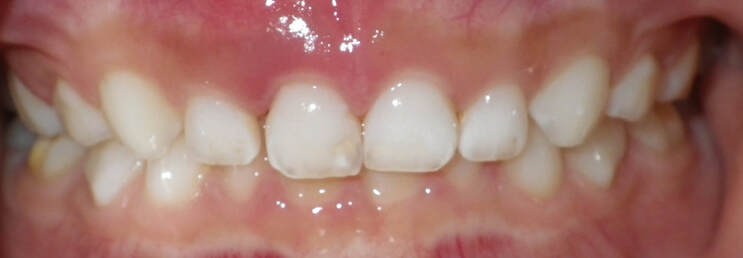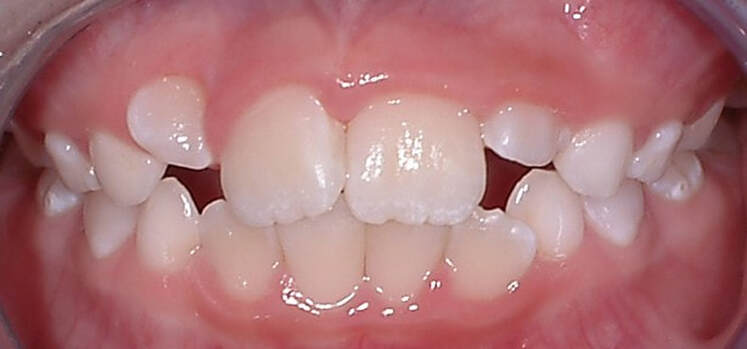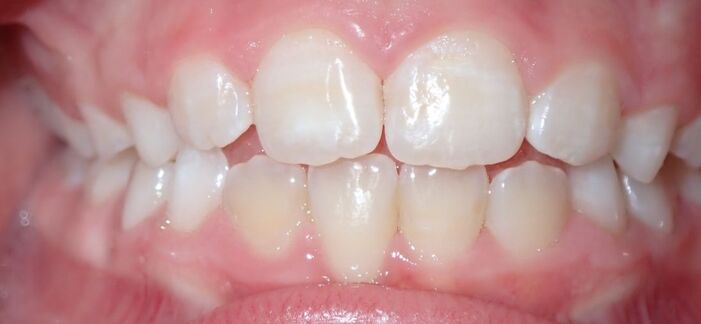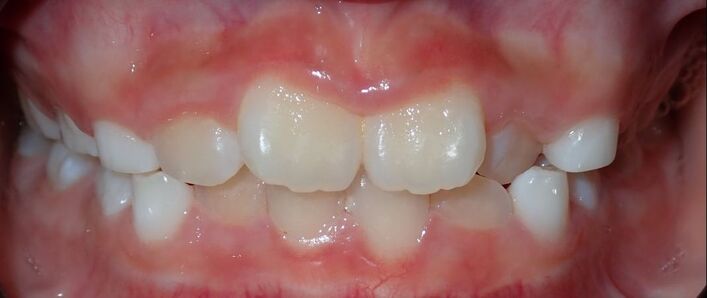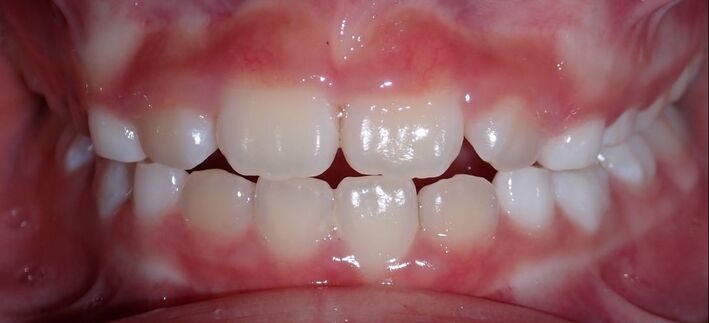Kids as young as 3 years old can start myofunctional appliance therapy. It is a more holistic, less invasive, less painful, and less expensive alternative to braces.
Check out some of our patients' cases below!
Our patient's case using just myofunctional appliances from age 3 through age 12. Treatment will continue until adult teeth (not including wisdom teeth) are fully erupted. Almost all patients will have retention of their straight teeth and won't need retainers.
Another patient's case who started treatment at age 5 and has full retention of her straight teeth at age 21. She doesn't need retainers to maintain her gorgeous smile! She also opted for whitening and conservative edge bonding on 4 front teeth to perfect her smile.
See crowding or spacing similar to your childs? They may be a great candidate for a myofunctional appliance. Straight teeth without wires!
Below are some of our patients' active cases. Treatment will continue until all their permanent teeth (not including wisdom teeth) are fully erupted, after which residual spacing will close.
As you can imagine, both the parents and kids are thrilled with the results and visible changes at each visit!
Understanding Myofunctional Therapy/Appliances
Myofunctional therapy/myofunctional appliance wear is a minimally invasive, and more holistic approach to treating children with maloccolusion (misalignment of teeth like crowding or excessive spacing) in the dental office. It is used to treat patients who are mouth breathers, have a tongue thrust, thumb sucking habits, or other tongue or cheek muscle habits. These are known as incorrect myofunctional habits. A few symptoms of incorrect myofunctional habits are snoring and teeth grinding during sleep. Myofunctional therapy can be used to treat the cause of these symptoms.
A myofunctional appliance is an alternative to braces, which is less expensive, and less painful. More importantly, not only does this treatment straighten teeth, it also helps your child’s face develop to its full potential. This type of treatment is aimed to treat the cause of malocclusion and jaw development, rather than the symptoms (as traditional orthodontics do). While braces/Invisalign can straighten teeth, if the initial cause of the malocclusion is not addressed, the patient’s teeth will relapse back to their maloccclusion. The earlier a child begins treatment to address the causes of malocclusion, the better retention they will have of their straight teeth and the more successful their treatment will be.
A tell tale sign of incorrect myofunctional habits is the pediatric patient with bags under their eyes. This indicates a mid-face deficiency and lack of growth. The presence of under eye bags, or venous drainage, is due to the cheek bones failing to grow forward. They instead grow down and back, leading to a "long-face" appearance. This development also acts to narrow the airway, which leads to snoring and teeth grinding.
The earlier incorrect myofunctional habits are corrected, the less problems the patient will have later in life. By age 5, majority of children in the US will already show signs of malocclusion and the need for orthodontic treatment. By age 14, 90% of facial development is complete. Though orthodontics can still make the teeth look straight, it cannot significantly change the shape of the face as myofunctional therapy would.
My child snores and grinds really loud! Is there anything you can do, Doc?
We absolutely can! Our dentists are able to perform an exam to determine if your child would be a good candidate for a myofunctional appliance. Proper appliance wear would help treat the cause of the snoring and grinding symptoms. Your child would get a good nights sleep, while also protecting their precious first set of teeth and promoting proper facial development.
Snoring and grinding are tell tale signs of sleep disordered breathing or improper nasal breathing (mouth breathing). When the patient’s airway is narrow, they will breathe predominantly through the mouth rather than through the nose. It is also a sign of poor facial development.
Many children breathe through their mouths. Mouth breathing exposes the tonsils to toxins, allergens, and pollutants and can stress out the nervous system. Mouth breathing also disrupts the feedback to the upper jaw, leading to the downward, backward growth pattern seen in long-faced children with eye bags. Conversely, nasal breathing cleans, warms and humidifies the air and causes a relaxation response.
Myofunctional therapy can be used to open the airway by posturing the jaw and tongue positioning. This treatment helps regulate the airway and allow adequate oxygen flow and proper growth and development of the jaws and facial structure.
Myofunctional therapy/myofunctional appliance wear is a minimally invasive, and more holistic approach to treating children with maloccolusion (misalignment of teeth like crowding or excessive spacing) in the dental office. It is used to treat patients who are mouth breathers, have a tongue thrust, thumb sucking habits, or other tongue or cheek muscle habits. These are known as incorrect myofunctional habits. A few symptoms of incorrect myofunctional habits are snoring and teeth grinding during sleep. Myofunctional therapy can be used to treat the cause of these symptoms.
A myofunctional appliance is an alternative to braces, which is less expensive, and less painful. More importantly, not only does this treatment straighten teeth, it also helps your child’s face develop to its full potential. This type of treatment is aimed to treat the cause of malocclusion and jaw development, rather than the symptoms (as traditional orthodontics do). While braces/Invisalign can straighten teeth, if the initial cause of the malocclusion is not addressed, the patient’s teeth will relapse back to their maloccclusion. The earlier a child begins treatment to address the causes of malocclusion, the better retention they will have of their straight teeth and the more successful their treatment will be.
A tell tale sign of incorrect myofunctional habits is the pediatric patient with bags under their eyes. This indicates a mid-face deficiency and lack of growth. The presence of under eye bags, or venous drainage, is due to the cheek bones failing to grow forward. They instead grow down and back, leading to a "long-face" appearance. This development also acts to narrow the airway, which leads to snoring and teeth grinding.
The earlier incorrect myofunctional habits are corrected, the less problems the patient will have later in life. By age 5, majority of children in the US will already show signs of malocclusion and the need for orthodontic treatment. By age 14, 90% of facial development is complete. Though orthodontics can still make the teeth look straight, it cannot significantly change the shape of the face as myofunctional therapy would.
My child snores and grinds really loud! Is there anything you can do, Doc?
We absolutely can! Our dentists are able to perform an exam to determine if your child would be a good candidate for a myofunctional appliance. Proper appliance wear would help treat the cause of the snoring and grinding symptoms. Your child would get a good nights sleep, while also protecting their precious first set of teeth and promoting proper facial development.
Snoring and grinding are tell tale signs of sleep disordered breathing or improper nasal breathing (mouth breathing). When the patient’s airway is narrow, they will breathe predominantly through the mouth rather than through the nose. It is also a sign of poor facial development.
Many children breathe through their mouths. Mouth breathing exposes the tonsils to toxins, allergens, and pollutants and can stress out the nervous system. Mouth breathing also disrupts the feedback to the upper jaw, leading to the downward, backward growth pattern seen in long-faced children with eye bags. Conversely, nasal breathing cleans, warms and humidifies the air and causes a relaxation response.
Myofunctional therapy can be used to open the airway by posturing the jaw and tongue positioning. This treatment helps regulate the airway and allow adequate oxygen flow and proper growth and development of the jaws and facial structure.






